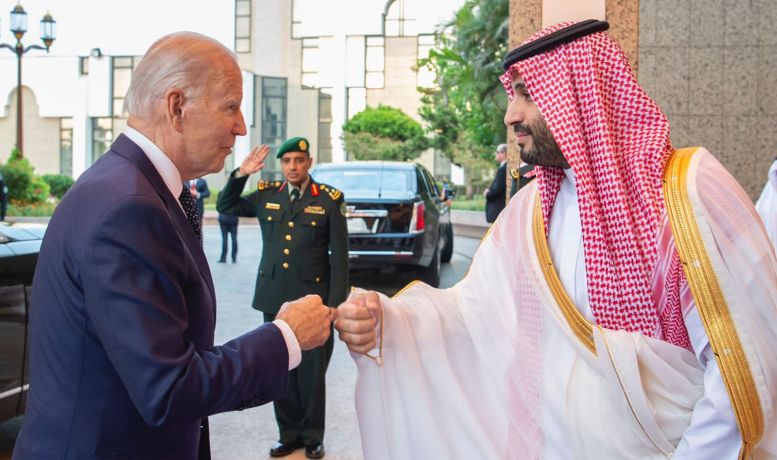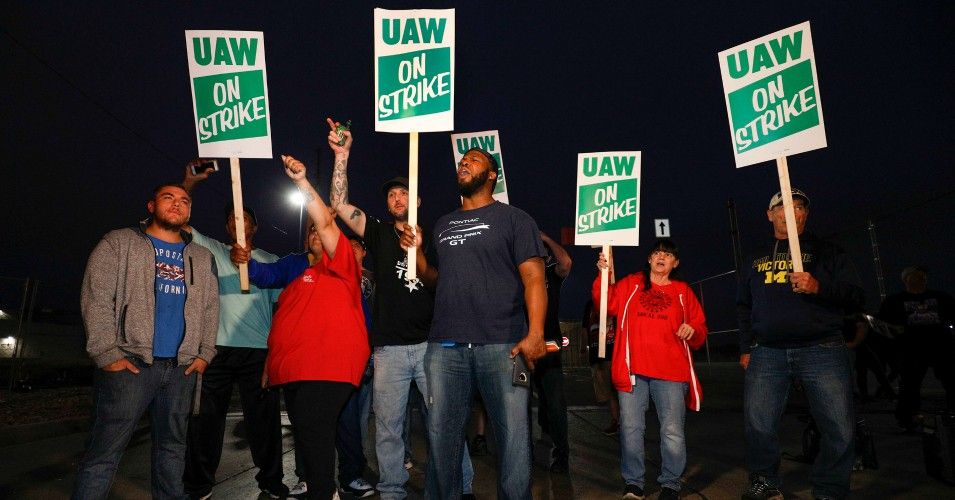Vincent Kolo is a contributor to chinaworker.info.
Rather than hitting the pause button on the imperialist US-China Cold War, Russia’s invasion of Ukraine has fast forwarded processes.
“The Russian invasion of Ukraine has put an end to the globalization we have experienced over the last three decades,” says Larry Fink, chairman of Blackrock, the world’s biggest financial speculator. A great many capitalists, like Fink, are playing catch-up with the new realities in the world situation. Up until earlier this year they still spoke of a Cold War between the two superpowers, China and the US, in the future tense.
But in fact, the general outline of today’s US-China conflict began a decade ago with President Obama’s “Pivot to Asia”. At the same time, in 2012, Xi Jinping came to power and adopted a more aggressive and nationalistic foreign policy. This was the flipside of greatly increased repression and hardline control at home. Xi jettisoned the pragmatic diplomatic doctrine of previous Chinese governments summed up in Deng Xiaoping’s phrase, “hide and bide” (hide your capacities and bide your time). Xi’s approach is distinguished by boastfulness and an exaggeration of China’s capacities. An example is China’s disappointing results in producing vaccines against COVID-19 despite investing hundreds of billions of dollars in its biopharma sector in recent years.
The conflict with US imperialism escalated in 2018 under the right-wing populist Trump presidency, with the launch of the biggest trade war since the 1930s. When Trump lost to Biden in 2020, we explained the Cold War would continue and escalate under the new administration. This is because the conflict is rooted in objective processes, the historic crisis of global capitalism, and is not ultimately dependent on which capitalist party is in control.
In ISA’s 2020 congress resolution on world perspectives we said, “the US-China conflict is now the main axis around which the global situation revolves”. As this resolution spelt out: “World capitalism is exiting the era of neoliberal globalisation, the dominant trend for almost four decades, and entering the era of ‘geo-economics’ in which the clash of interests between the major imperialist powers is the dominant factor.”
State over market
This was written before the pandemic and before the Ukraine war, both of which have reinforced these processes. Today this has tilted further towards militarism and an even sharper geopolitical power struggle, with economic trends tending to follow rather than leading developments. National states — capitalism’s tools of coercion — rather than “market forces” are increasingly in the driving seat. Military expansion and strategic deglobalization are now the main trends. This is not just about increased arms budgets, although that is a dramatic and alarming development with Japan and Germany being the standout examples.
China now boasts the world’s biggest navy, with 355 ships compared to America’s 297, and in June launched its third and most advanced aircraft carrier Fujian. Xi’s modernization plan envisages a military “on a par with the US” by 2027, the 100th anniversary of the People’s Liberation Army. Many commentators warn this could be Xi’s timetable for an invasion of Taiwan, which he is determined to bring under Beijing’s control. However, China has not fought a naval war for 100 years. Military experts warn an invasion of Taiwan would be even more complicated than the 1944 D-Day landing in Normandy.
A hysterical political climate is being orchestrated by the ruling classes, in Europe but also in parts of Asia, with preparations alongside this for massive attacks on the working class to finance bigger and deadlier armies. Everywhere, the solution of the capitalists and their governments is “more arms!” Nationalism, a certain hysteria and disorientation, are very common in the early stages of a war. But the tide will inevitably turn with support growing for an anti-war, anti-capitalist and internationalist alternative.
The recent NATO summit in Spain, the G7 meeting in Germany, and the Quad leaders’ summit in Japan were all historic as examples of a new level of coordinated Western push back not just against Russia but also crucially against China. The new level of rhetoric against China, which for the first time is labelled a “systemic challenge” in NATO’s 2022 Strategic Concept, is proof that blunting Chinese power is the overriding long-term goal of US imperialism and now also of NATO. This strategic focus was underlined in a recent speech by Britain’s naval commander Admiral Sir Ben Key who warned, “focusing solely on the Russian bear risks missing the tiger.” The point is clear even if there are very few tigers in China (evidently a grasp of zoology is not required to lead a navy).
Russia’s invasion of Ukraine was of course the first item on the agenda at these meetings, except at the Quad summit where the involvement of India’s Modi required some different messaging from that group’s other members, the US, Japan and Australia. India refuses to side against Russia, in part because it fears pushing Putin even closer to China. For years the Chinese regime has been lobbying Russia to cut its arms sales to India, with which Beijing has a long-running border dispute. Part of Xi’s calculations in giving his de facto support to Russia’s invasion is to use this as leverage against India and for China to get its hands on Russian military technology including nuclear weapons technology.
Armageddon
The crippling sanctions levelled against Russia, which has effectively been ejected from the world economy, serve a double purpose — also as a warning and dress rehearsal for a future showdown with China. In that event, the global impact would be on an altogether different scale. China’s economy is ten times bigger than Russia’s and is critical to global supply chains, trade and financial flows. “Apply what we have seen in Russia to China, and you have Armageddon for the Chinese economy and for the global economy,” a Western corporate leader told the Financial Times.
Both sides want to avoid or postpone such a scenario. But both sides are also preparing for when the day comes. Even Henry Kissinger, who negotiated to bring Mao’s China into the Western camp during the original Cold War against Stalinist Russia, agrees that today’s capitalist China must not be allowed to become a “hegemon.” This, despite Kissinger’s warnings that US-China hostilities could trigger a global “catastrophe comparable to World War I.”
The blowback from the Ukraine war has enabled US imperialism to align more of its allies around its anti-China strategy. Differences persist, for example with the German government, which in the eyes of the Biden Administration is still dragging its feet over both Russia and China. But compared to where the respective governments stood before the February invasion, the gap has narrowed significantly.
The new situation has also delivered a financial windfall for the US arms industry. When the German government decided to double its military budget just days after Russia’s invasion, from €47bn in 2021 to €100bn in 2022, its first purchase was 35 American F-35 fighter jets capable of carrying nuclear weapons (estimated cost €4 billion). The US energy industry also stands to reap huge gains as Germany and Europe turn away from Russian oil and gas. In the first four months of the year, liquefied natural gas shipments from the US to Europe tripled compared to the same period in 2021.
NATO and friends
At the Madrid NATO summit for the first time Japan, South Korea, Australia and New Zealand were invited to participate. This was not simply to send a message to Beijing, but also a step towards greater military coordination between these Indo-Pacific states and NATO. Consequently, while Xi Jinping may have calculated his regime could extract benefits from Russia’s confrontation with the West, he ultimately stands to lose even more than Putin because the stakes for the Chinese economy are much higher.
This concerns the wider process of deglobalization and formation of two antagonistic blocs, with China running the risk of being squeezed out of key market sectors and access to new technology. US tech billionaire Vinod Khosla predicts a “techno-economic war” between the US and China that he says will last two decades. The US has already imposed tough controls over strategically significant technologies such as 5G telecommunications equipment and semiconductors and its tech controls will only expand. Various bills are before Congress which aim to tighten the screening of US investments in a vast range of Chinese business sectors. Other measures aim to fund US production of semiconductors, rare earth metals, improved battery technology, and other sectors where either China is dominant or the US economy is vulnerable to supply chain disruptions.
Trump’s regulatory assault on Chinese telecom giant Huawei plunged the company into serious crisis. Blocked by US sanctions from accessing the latest semiconductors, its position even in China’s domestic smartphone market has fallen from first place to sixth place since 2018, with a drop in sales of 64 percent in the past year. Adding to its woes, Huawei has been forced to scale back its operations in Russia, one of its few growth markets, to avoid falling foul of Western sanctions.
The US “Entity List” or blacklist of Chinese companies set up during Trump’s administration, has since become a template for the conduct of US economic warfare in the Cold War era. Under Biden the “Entity List” has been expanded and Chinese media say 260 Chinese companies are now on the list. More than 100 Russian companies were added in February.
Tariff cuts?
Further escalation is on the cards. “If the US persuades the EU and Japan to revive the Coordinating Committee for Multilateral Export Controls (CoCom) to choke off technology flows to China — a prospect made more likely by the Ukraine war — China will have little chance of winning the technology race with the US,” argues Minxin Pei, a Chinese-American commentator.
This is not contradicted by reports that Biden is deliberating the possible removal of some tariffs on Chinese goods imposed by Trump in 2018. If this happens the reduction will probably be “modest,” perhaps removing less than 3 percent of the tariffs, which totally cover over $300 billion worth of Chinese goods. The aim would be to ease inflationary pressures in the US economy in the run-up to the November midterm elections, although this may have no effect on inflation.
Conflicting statements suggest there’s a power struggle within Biden’s government between the Treasury and Commerce departments, with any reduction in tariffs likely to open the president up to attacks from both sides of Congress for going soft on China. It is not only in China that manic nationalism is a constraint on the government’s ability to refine policy. Janet Yellen, who seems to support some “recalibration” of the tariffs, argues they are not particularly effective as a weapon against China and that more “strategic” tariffs are needed. So, this debate is about how to inflict pain on China’s economy more smartly, nothing else.
EU-China relations
For much of the past decade Beijing held out the hope that the European Union, under de facto German leadership, would hold to a position of “strategic neutrality” in the US-China conflict. This hope was based on the belief German capitalism would not do anything to jeopardise more than $100 billion dollars of German exports to China annually. But Xi Jinping’s attempts to inoculate EU-China relations from the US-China Cold War began to self-destruct even before the Ukraine war.
Tensions over Xinjiang torpedoed the EU-China Comprehensive Agreement on Investment (CAI) in March last year. Had this deal been ratified it would have been a significant diplomatic coup for Beijing and a rebuff to Washington. But the CAI is now dead in the water. This year, the German government is exerting financial and political pressure on its biggest companies including carmaker Volkswagen, citing the Chinese dictatorship’s human rights abuses in Muslim-majority Xinjiang.
The Xinjiang issue is being used to flag a new tougher approach from Berlin, towards China but also towards the German capitalists, to force their hand to “diversify” their investments and supply chains to end a lopsided dependence on China. This is a global trend. It mirrors the policies of the US and other countries where governments are increasingly dictating investment decisions to private companies on “national security” grounds. It mimics some features of the Chinese model.
Such a “statist” approach was unthinkable during the heyday of neo-liberal globalization. But today each ruling class needs to protect their national power in order to survive what Martin Wolf of the Financial Times calls the “new era of world disorder.” It is this rather than concerns over repression and torture, which occur on a vast scale in Xinjiang, that forces Germany and other Western economies to slam the brakes on greater economic interdependency with China. This decoupling from China’s economy is still in its early stages but it is accelerating, as some of Xi’s internal critics warned would happen, putting the blame on his “no limits” alliance with Putin.
The process in fact began almost ten years ago, driven by other factors including a rise in Chinese wages compared to other Asian and even Eastern European economies. But in the first half of this year, 11,000 foreign companies were de-registered in China, compared to a net increase of 8,000 new foreign registrations last year.
Everbright Securities estimates that around seven percent of Chinese furniture orders were lost to Vietnam and other countries between September 2021 and March 2022, five percent for textile products and two percent for electronics. These trends have been masked by the temporary boom for Chinese exports during the pandemic, but as that now fades, there is likely to be a “hollowing out” of Chinese manufacturing — similar to what happened in Japan thirty years ago.
Democratic rights
The US-led camp frames its stance over Ukraine as a defence of “democracy” against “autocracy.” The same hypocrisy extends to Xinjiang and Taiwan. The propaganda of Chinese and Russian imperialism relies on aggressive nationalism (“wolf warriorism” in China). They blame the West for seeking to weaken and destroy the Motherland, using “democracy” as one of its insidious weapons. All regime enemies — workers, anti-war and democracy activists, LGBT+ people and feminists — are labelled “foreign agents.” The nationalist project is about becoming a strong power and recapturing “stolen territories.”
Marxists and ISA oppose all the imperialist powers or blocs and their propaganda. We warn that to give support to either camp or to believe one imperialism is less dangerous than the other would have disastrous consequences for workers’ struggle against capitalism.
Imperialism is never an ally in the struggle for the liberation of oppressed peoples and nations, and not on the side of democratic rights for the masses. The political freedoms that currently exist in Western capitalist democracies but are completely absent in China and increasingly also in Russia, such as the right to vote, to organise, freedom of speech and the right to strike — these rights have always and everywhere been won through mass pressure and struggle, not from the benevolence of the ruling class.
The US state’s ferocious attack on the right of abortion makes a mockery of Washington’s attempt to take the “democratic” high ground. Western capitalist countries have launched wave after wave of attacks on civil liberties and trade union rights in recent years. In countries with formal or bourgeois democracy it is not the capitalist state that is the repository of democratic rights.
Leon Trotsky explained that if the working class is not immediately capable of overthrowing capitalism, it defends bourgeois democracy against fascist or authoritarian reaction: “The workers defend bourgeois democracy, however, not by the methods of bourgeois democracy … but by their own methods, that is, by the methods of revolutionary class struggle.” (Answers to Questions on the Spanish Situation, 1937).
“Good autocrats”?
Working people can never look to the capitalist state, the courts, the police, or capitalist armies to defend our democratic rights. The democratic rights that exist in Western capitalist states are the result of struggle and the class balance of forces in society, rather than what is written in laws or constitutions. Only mass struggle linked internationally and led by a revitalised workers’ movement that fights to replace capitalism with genuine socialism can secure real democratic rights. This is the only force that can end wars and national oppression. Socialists oppose the Orwellian state repression of the Chinese and Russian capitalist states and stand on the side of the working class in these countries, which is the only force that can wage a real struggle against dictatorship.
When NATO needs Turkey to approve the membership applications of Sweden and Finland, its “democratic” leaders have no qualms about cozying up to the ruthless autocrat Erdogan who is preparing new wars against the Kurds, as well as attacking the rights of trade unions, women and LGBT+ people.
The same breathtaking double standards apply to Biden’s recent visit to Saudi Arabia to fist bump dictator Mohammed bin Salman. Biden on the campaign trail two years ago boasted he would turn Saudi Arabia into a “pariah”, but now he needs a deal over oil supplies as the Russian oil embargo squeezes global markets. So, it was also with Blinken’s mission to charm Thailand’s dictator General Prayut in July. Washington is anxious not to see the Thai regime shift completely to China’s side.
A clear analysis
The US-China imperialist conflict inserts itself into almost every movement and struggle occurring around the world. We saw an element of that in Myanmar last year, where on one side the army’s coup was supported by Beijing and Moscow, while on the other side a section of the youth and workers who mounted an incredible resistance struggle and mass strike movement unfortunately began to look towards Western pressure and even intervention (by the so-called international community) to help them defeat the junta. This was a cruel illusion which only played a confusing role in the struggle. The same occurred in a different form in Hong Kong during the mass democracy protests of 2019, and again in Thailand the following year.
There are important political lessons from these experiences in the changed global environment created by the new Cold War. In the aforementioned examples a variant of “lesser evilism” took hold and disoriented a section of these movements, leading to or reinforcing a downturn in the struggle. Also, in countries like Indonesia, the Philippines, Malaysia, Japan, Taiwan and South Korea, sections of the workers’ movement and the Left can be disorientated and divided by these complications. Of course, this is a warning for the nascent workers’ movement in China as well.
The Cold War, with the two imperialist blocs exploiting and further polarising already volatile situations to rack up geopolitical wins, represents a serious danger to workers and youth. This is the case even without another hot war replicating and perhaps eclipsing the horrors of Ukraine. A clear perspective, analysis and program that rejects “lesser evilism” and nationalism for an internationalist and working-class position of implacable opposition to all capitalist and imperialist governments, this is the only way to ensure important struggles of the oppressed are not derailed by reaction.




